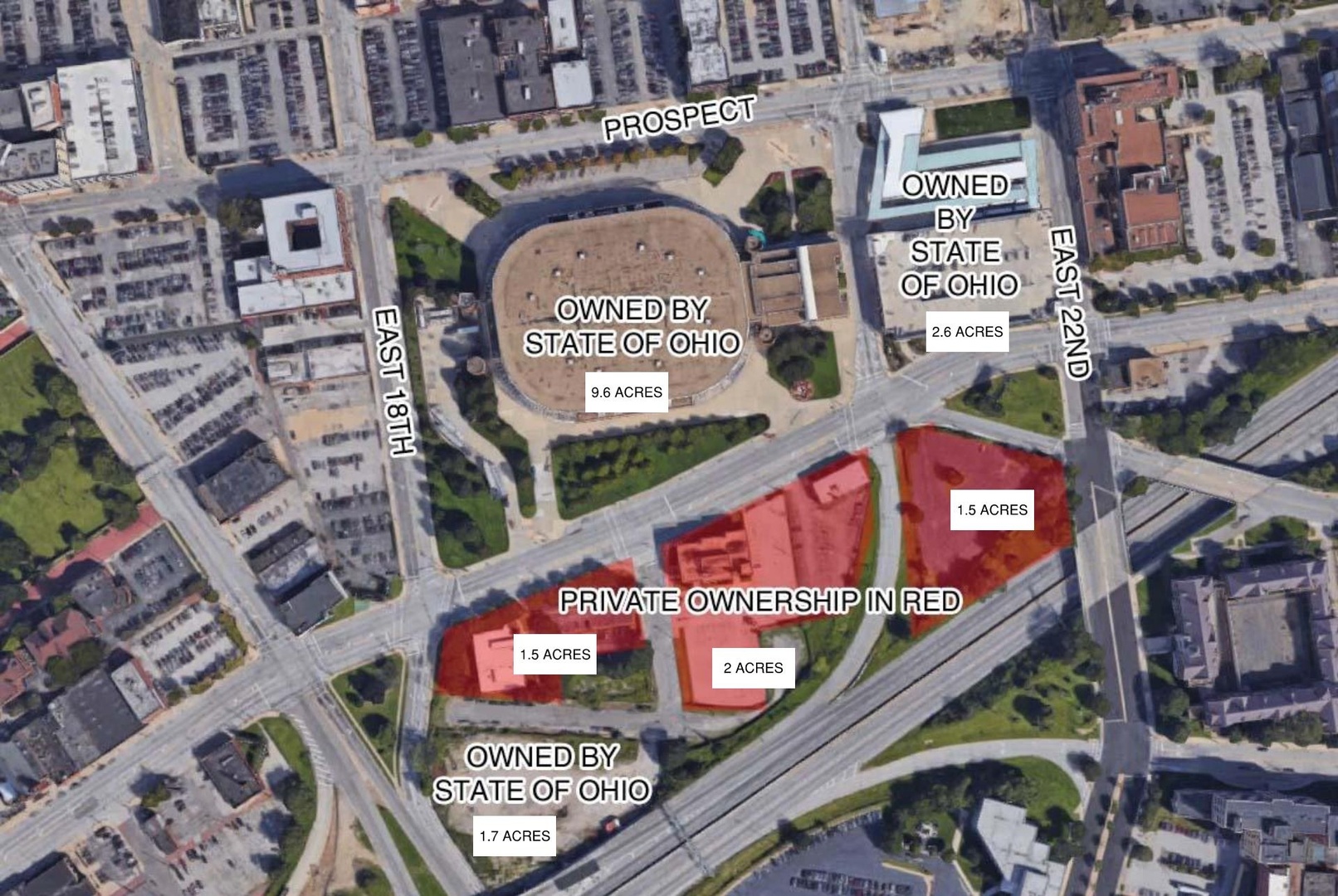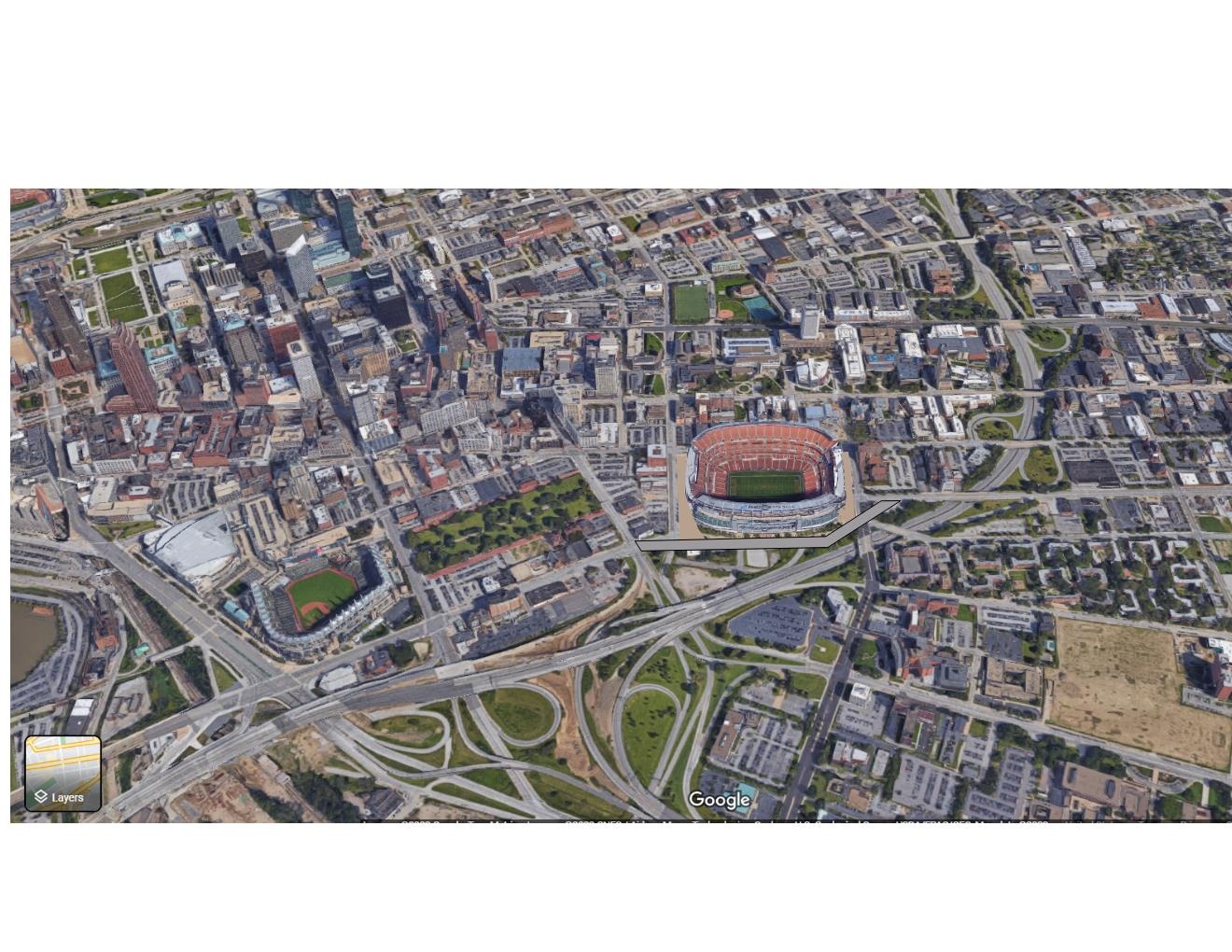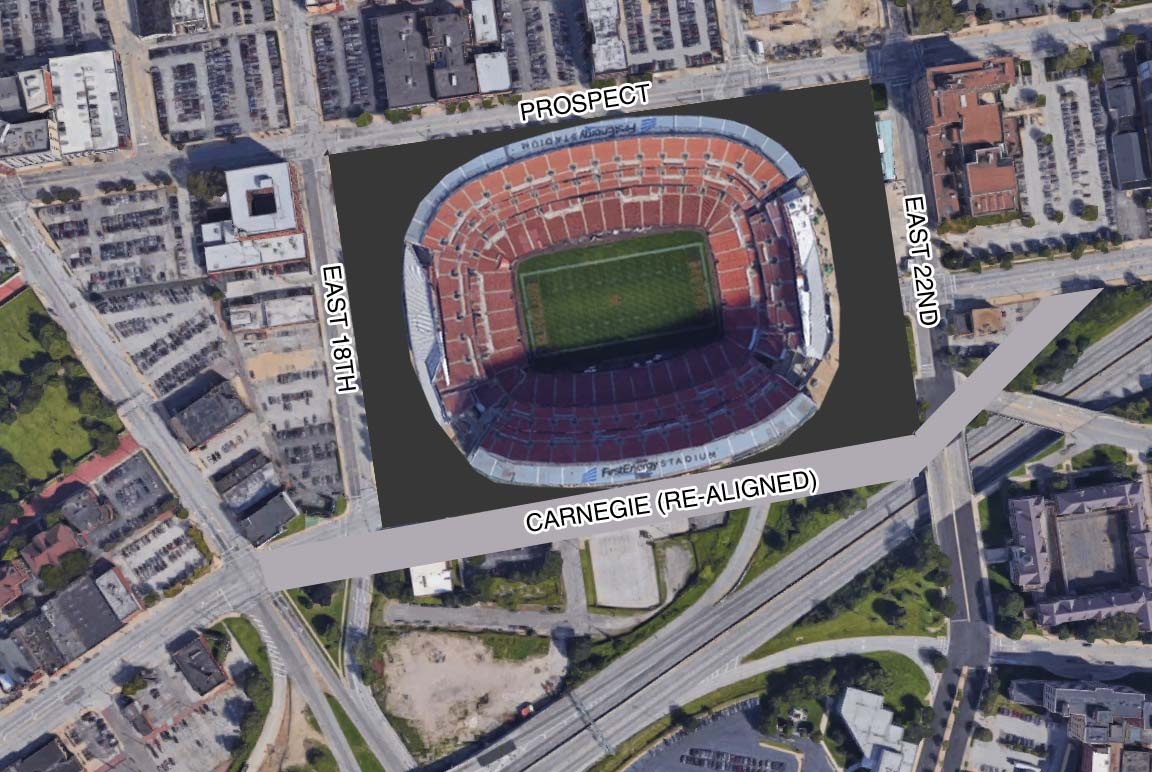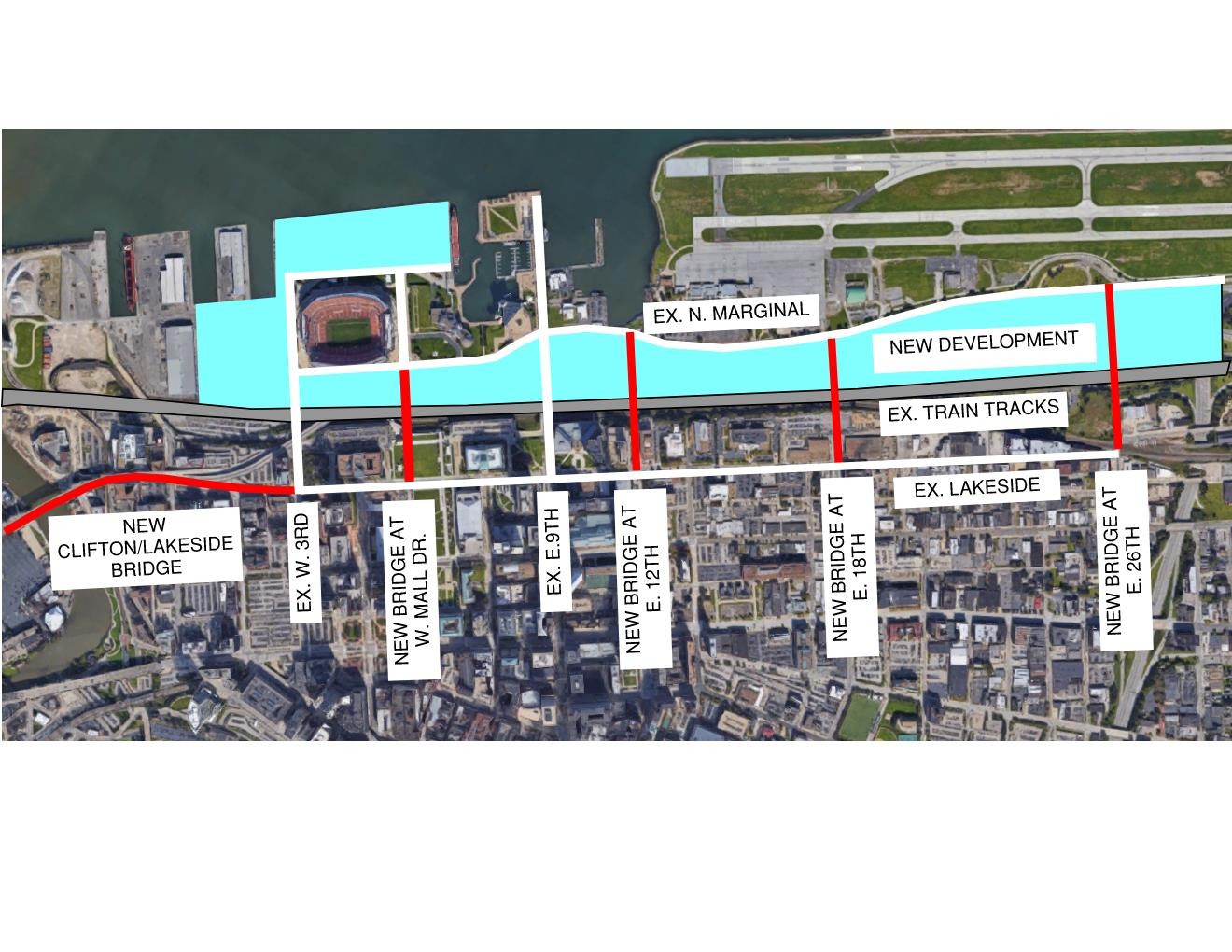Everything posted by Dino
-
Cleveland: Scranton Peninsula: Development and News
Is Great Lakes still building their brewery on the peninsula? What's the status of that project?
-
Cleveland: Downtown: Justice Center Complex Replacement
Journalism has gotten so terrible. You would think the article would include an address or description of the location. I eventually found the location but geez, it shouldn't be that hard.
-
Cleveland: Downtown: Tower City / Riverview Development
Valuable? It's vacant land sandwiched between an abandoned steam plant and mounds of iron ore and has been used as surface parking for decades. Even the street (Eagle Ave.) to this piece of land has been abandoned. And two of Cleveland's biggest stakeholders want to invest $20M+ (my own off the cuff estimate for a 50,000sf building with parking) to put a 4-5 story building (that's what the massings show) in this location? That's not short sighted at all. This location is really only attractive if the Riverfront Plan gets built out and that could take decades to happen. I think the announcement is a signal in they are betting on the future.
-
Cleveland: Downtown: Tower City / Riverview Development
I don't know if it was intended or not, but this project, in this location kind of demands that the major infrastructure issues be addressed, and be addressed right away. There can be no feet dragging in rebuilding Eagle Ave, or Canal Road. It also shines a major spotlight on the Thermal Plant. Once these infrastructure dominoes fall, the rest of the riverfront plan seems like an open runway. Very exciting.
-
Cleveland: Downtown: Justice Center Complex Replacement
^ The tower could also work for Rocket Mortgage too, but it might be too big for them and I would be shocked if they aren't already planning to build on the riverfront
-
Cleveland: Downtown: Justice Center Complex Replacement
It can definitely be reused. Residential would be fine, but my first thought was the tower could be a potential HQ for Cle Cliffs. I think it's about the right size. An office conversion would probably be easier than residential and the floorplates would be more efficient for office. Plus the site would still have space for a garage wrapped with residential.
-
Cleveland: Lakefront Development and News
I just posted this in the Browns Stadium thread, but it probably belongs here... I think the Lakefront and Riverfront are interesting comparisons. They are two waterfront properties of somewhat relatively similar size and adjacent to downtown. They are both largely cutoff from downtown, have huge infrastructure hurdles to development, and have been discussed and masterplanned for decades with no results. They both have major stakeholders with deep pockets. That said, both are approaching development in completely different ways. The prevailing approach to the Lakefront has been "...if only these major infrastructure hurdles could be fixed, there's no doubt that large scale, first class would surely follow" ...it seems they are waiting for the bureaucrats to take the lead. Meanwhile on the Riverfront, the prevailing approach appears to be "...we're bringing large scale, first class development to this site. Once we have the projects tee'd up, we'll tell you what we need to make it happen"...it seems like developers are taking the lead here. It's kind of a chicken and egg thing and it will be interesting to see which approach will result in development and investment.
-
Cleveland: Downtown: Huntington Bank Field
I think the Lakefront and Riverfront are interesting comparisons. They are two waterfront properties of somewhat relatively similar size and adjacent to downtown. They are both largely cutoff from downtown, have huge infrastructure hurdles to development, and have been discussed and masterplanned for decades with no results. They both have major stakeholders with deep pockets. That said, both are approaching development in completely different ways. The prevailing approach to the Lakefront has been "...if only these major infrastructure hurdles could be fixed, there's no doubt that large scale, first class would surely follow" ...it seems they are waiting for the bureaucrats to take the lead. Meanwhile on the Riverfront, the prevailing approach appears to be "...we're bringing large scale, first class development to this site. Once we have the projects tee'd up, we'll tell you what we need to make it happen"...it seems like developers are taking the lead here. It's kind of a chicken and egg thing and it will be interesting to see which approach will result in development and investment.
-
Cleveland: Downtown: Huntington Bank Field
I just read an interesting article about the economic impact of stadiums. Among other points, it highlights what @GISguyis getting at by describing what they call an "opportunity cost". Basically, if we get use taxpayer money for a stadium, it means we're not getting something else with that money. https://fee.org/articles/the-myth-that-sports-stadiums-create-new-jobs-and-tax-revenues/
-
Cleveland: Downtown: Huntington Bank Field
Here's another way to look at a new stadium...Look at Mercedes Benz Stadium in Atlanta. It was built in 2017 and cost $1.6 BILLION!!! That sounds like a lot, but it had 3.3 million visitors in the first year! That's $485/visitor for just one year. A Browns stadium renovation will cost about $550M, likely won't include a roof, and likely won't significantly change attendance numbers. So that's roughly $1000/visitor in a year for a renovation. Let's assume Cleveland builds a domed stadium like Atlanta's. Let's say it isn't quite as fancy so the $1.6B price tag remains the same in today's dollars. Let's also assume that Cleveland isn't the regional or even national destination that Atlanta is (I know, it's tough to imagine), so it's annual attendance is only half of Atlanta's, at 1.65M visitors. That would still come out to roughly $1000/visitor, but we've tripled the number of overall visitors. Personally, I think there's pros and cons to building vs. renovating but this is the type of stuff I think about when left to my own devices.
-
Cleveland: Downtown: Huntington Bank Field
^Granted, I would love it if our downtown was so jam packed with skyscrapers we couldn't afford to give up the real estate for a stadium, but that's not the case in Cleveland, or really any other US city except NYC.
-
Cleveland: Downtown: Huntington Bank Field
This isn't directed @LibertyBlvd, but the comment made me think about how much land we are using downtown, and how many people it actually brings in. Let's call it "visitor density." Although a football stadium isn't used often, it does bring a lot of people to a City. How does that compare to other attractions downtown? I didn't include parking or another adjacent uses: Location Annual visitors Acreage Visitors/Acre SHW HQ 806,000 (3100x260days) 2.7 298,519 R&R HOF 543,000 3 181,000 RoMoFiHo 843,000 7 120,435 Progressive Field 1.3M 16.7 77,844 GLSC 300,000 7.5 40,000 Browns Stadium 540,000 17.4 31,034 Convention Center 236,000 15.5 15,225 While the density isn't great for a football stadium, it's not terrible either, and I would really hate to let half a million visitors slip out of the immediate downtown area, even if it takes up a lot of space. If we do build a new stadium I would really want it between the river and innerbelt somewhere. We have too much space and not enough people downtown. That's my opinion anyway.
-
Cleveland: Downtown: Huntington Bank Field
I hear ya @LibertyBlvd! There's some decent sites south of downtown. The Orange Ave. Post office wouldn't be bad and that one site people mentioned for a soccer stadium wouldn't be bad either.
-
Cleveland: Downtown: Huntington Bank Field
Yes. Because the infrequently used facility is bringing in hundreds of thousands of people into the City every year and you want those visitors to take advantage of shared amenities like hotels, restaurants, parking garages, and public transit options. The other way to look at it is to ask, "Is it a good idea to build miles and miles of roads, acres of parking, hundreds of hotel rooms and dozens of bars and restaurants in a greenfield site that will be infrequently used?" That was the mindset in the 1960's. @enginerd12I've previously commented on leaving the stadium where it is and renovating. It's a shame to keep rebuilding stadiums every 30 years. BUT, the stadium will have to be rebuilt at some point, and unless the team leaves again, it will have to be rebuilt in a new location. IF, that is to happen now, I can't think of a better site in the City that E. 18th and Prospect. But I also think there is merit in renovating the existing stadium.
-
Cleveland: Downtown: Huntington Bank Field
I call it the Wolstein site, but I'm talking about the land bounded by Prospect and I-90, between E. 18th and E. 22nd. You would need to demo Wolstein (already happening), a parking garage, the transit station, and 3 small commercial buildings. This land totals about 19 acres and you might get another acre once E. 21st is vacated, so let's call it 20 acres. The current Browns stadium is on a 17.5 acre site. It might be a tight fit, but it seems like it would fit. And it's an urban site, so you want a tight fit, right?
-
Cleveland: Downtown: Huntington Bank Field
Here's a very crude rendering of a stadium at the Wolstein site. BONUS: Leave the west end of the stadium open and it will frame the Terminal Tower perfectly! Google Lumen Field in Seattle to see what I mean.
-
Cleveland: Downtown: Huntington Bank Field
It doesn't have to be that way. I think the one thing everyone (Browns, City, County, etc.) agrees on is a stadium surrounded by development, so I don't see that happening. Indianapolis, Seattle, Detroit, and Minneapolis have their stadiums just slightly outside of downtown and they don't have tons of surface parking (some, but not tons.) Plus you already have a lot of parking capacity between CSU, Playhouse Sq. and Gateway. And, just to the south, look at all the parking at St. Vincent's and Tri-C. There's already tons of parking in this area. I really don't think parking would be an issue at this site at all.
-
Cleveland: Downtown: Huntington Bank Field
I'm surprised the Wolstein Center site isn't even in the mix. This location seems so obvious to me. This site would be the easiest in terms of site acquisition, since it's already owned by the State/CSU and I think they'd be more open to making a deal than private landowners, or they could even donate it as part of their support package. This site would be pretty easy as far as needed infrastructure since it's already the site of an arena, so access and parking is already there. I think you'd have to move Carnegie a little, but that's not too big a deal compared to most other sites. The City wouldn't have to do too much else. It's directly downtown, and is not cut off by highways, train tracks, or topography. It would be easy to get to since it's right on the innerbelt and 1 block from Euclid, and there's parking everywhere. I really don't see a downside to this site.
-
Cleveland: Downtown: Tower City / Riverview Development
If Rocket Mortgage moved into Landmark, that would be a good thing wouldn't it? Or at least not bad? I'm sure they'd redo the office space no matter what. New buildings are nice and all, but we gotta find a use for Landmark at some point. Anyway, with 1 million sf of space, the building is big enough for a large company PLUS hundreds of apartments. That wouldn't be bad at all.
-
Cleveland: Cleveland State University: Development and News
That's what they said about the Schofield Building in the 1960's. I'm not knocking renovations like this- I often love them- but Rhodes is a very well preserved example of Brutalist architecture. It's not my favorite style, but it is iconic, and it is kind of a "classic" at this point. I would vote for not altering the facade.
-
Cleveland: Cleveland State University: Development and News
What strikes me about the masterplan is that it feels like a typical American city at a small scale. There's the central business district that in this case is the "academic core", with residential at the periphery. Building height and density also increases at the center. I realize CSU is working with a campus that was planned and built 50-60 years ago, so it is what it is. It also strikes me that they also seem to be trying to counteract that a bit by turning Rhodes into residential, and that mixed use building shown just west of Rhodes. That also seems to reflect American cities today in that they are striving for more integrated cities/land use. I could also be overthinking all of this!
-
Cleveland: Downtown: Huntington Bank Field
It al boils down to economics. There's no question that NFL teams generate millions in tax revenue and indirect economic activity. And there's no question that an NFL team will take those millions to whichever City provides the largest incentives (whether it's now or in the future). The $1 billion question is if Cleveland is getting a good deal, if it's worth keeping the Browns even if we think it isn't a good deal, and are we willing to call their bluff and hope they don't leave? Here's an interesting article on the Cost vs. Revenue of Browns Stadium https://signalcleveland.org/the-public-cost-of-cleveland-browns-stadium-hundreds-of-millions-and-counting/
-
Cleveland: Lakefront Development and News
The Landbridge is sexy and all, and it would be really iconic. BUT, I honestly think if we just reintroduce the street grid, develop the blue areas with real streetscapes and sidewalks, throw in a park and a lakefront promenade, it would be pretty great. Bridges over the train tracks aren't so bad if we shorten the distance by eliminating the Shoreway and create development on both sides worth going to. I don't know if this inspires "hope and healing for all", but it does reconnect downtown to the lakefront, provides equal access to pedestrians and cars, makes the lakefront more palatable to developers and is really, really achievable.
-
Cleveland: Lakefront Development and News
I would like to see the Shoreway simply merge into Lakeside at W. 6th and be completely eliminated along the lakefront from W. 6th to where it merges into 90. I would also like the West Shoreway to be a real boulevard like they intended it to be when they re built it several years ago. Then Clifton/Lakeside would be another Detroit/Superior type street. I don't think this would be a major inconvenience for anyone. West siders could still get downtown like they always have, and those going from the west-side to the east-side and vice versa (and really, who's doing that more than twice a year! HA!) have plenty of other highway options. This would uncomplicate things a lot and make the entire redevelopment scenario cheaper.
-
Cleveland: Downtown: Skyline 776 (City Club Apartments)
Home of the Dawg Pound!











